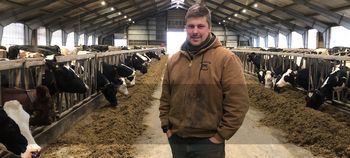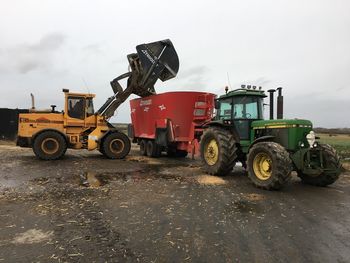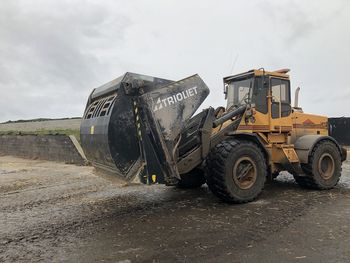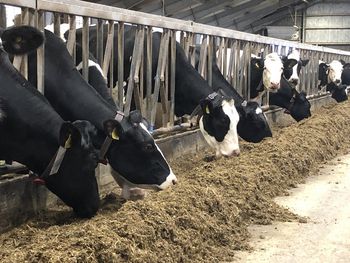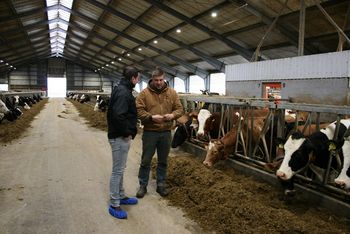Company: Van Heesch Dairy Partnership
Location: Skive, Denmark
Number of cows: 1,200, of which 650 milk cows (75% Holstein and 25% Jersey)
Production: 31.3 kg/35 kg ECM yield per cow per day
Hectares of land: 450 ha.
Mixer feeder: Solomix 3 3600 ZKX-T with Shifttronic 3-speed (2017)
Ration: 5.5 kg pellets, 8.5 kg water, 700 g minerals, 15.5 kg chopped grass and 21 kg maize
DM content: 36%
Number of feed turns per day: 3
Van Heesch Dairy Partnership, a milk cow farm with 650 milk cows (75% Holstein and 25% Jersey), is run by Rick van Heesch along with his brother, father and a permanent employee. The farm has been using compact feeding for more than five years. They soak pellets of concentrate feed with water, but not entirely according to the compact feeding theory. They don't let the mix soak for hours, but only for fifteen minutes. They also started mixing more intensively, for example by considerably extending the mixing and post-mixing time and increasing the auger speed.
A number of years ago, compact feeding suddenly became a trend in Denmark. Van Heesch Dairy Partnership were curious about the concept and tried to follow the compact TMR feeding protocol exactly as prescribed, but this proved not to be suitable for their business operations. Rick: "The long soaking time of concentrate feed takes too much time; it does not work with three feeds a day. We were able to find a method that suits us and we have benefited greatly from it. We add more than eight litres of water per cow to the pellets and let that soak for fifteen minutes so that the pellets disintegrate. Immediately after that, we load minerals and grass and mix for ten minutes before adding the maize. Once all components are loaded, we mix again for another ten minutes. Using our loading device, the Triomaster S, we can load three tonnes in one go. This means that we actually load too quickly and therefore have to mix for longer. In all, mixing takes about forty-five minutes."
Automatic powershift
Because of the water, the ration is heavier and more compact and that requires a lot power from the mixer feeder. Van Heesch have been using 36-cubic-metre Solomix 3 mixer feeders with a Shifttronic 3-speed powershift for more than two years now. Rick van Heesch: "Our previous mixer (a different brand) couldn't handle mixing the heavy ration day in, day out, not even with a planetary gearbox. But with the Shifttronic, we can do this almost effortlessly. I highly recommend it to everyone. You can shift up or down at the right moment and adjust the auger speed without having to get in and out of the tractor. This means you can continue to concentrate on the loading process and the gearbox will automatically shift to the right, pre-programmed gear. When we start discharging, we simply switch off the PTO. The tractor has no problem at all starting up and shifting up; it shifts up very quietly. With the previous mixer feeder we needed a new planetary gearbox every year!"
With compact TMR feeding, it is important that the feed components are short so that they adhere well to the other ingredients. Good auger knives are essential to this process, even with chopped grass. Rick: "The auger knives do their job well, as the ration is very homogeneous. The cows can't select, and that's what it's all about. To be honest, we've bought other auger knives but those were no good – they wore down in no time. Original knives may cost a little more, but if there's one thing we've learned over the last two years it's that you shouldn't cut back on equipment. Despite almost 3,000 hours of operation, the knives have only been replaced once. It's better to invest in quality, for in the end you reap the rewards."
What's the return?
Mixing for longer, investing in good equipment. What's the return on investment? Rick: "If we look at costs, we come to a total of 28.8 cents per litre of milk, 14 cents of which are feed costs. Including depreciation of the equipment and a diesel consumption of 14 litres per hour, we have to conclude that the return has improved in recent years. Not only are our below-the-line figures better, our cows are also doing well and are more stable. You can just see that they are calmer and they are all performing well now, where before we would have cows that were not optimally productive. So there's more stability across the entire herd. They are on a more equal footing in terms of yield, health and manure. There's a lot to gain if you focus on the feed in the feeding rack and pay more attention to mixing. Our cows are living proof of that."
Solomix 3 brochure View all diet feeders Ask a question
Recommended reading:
